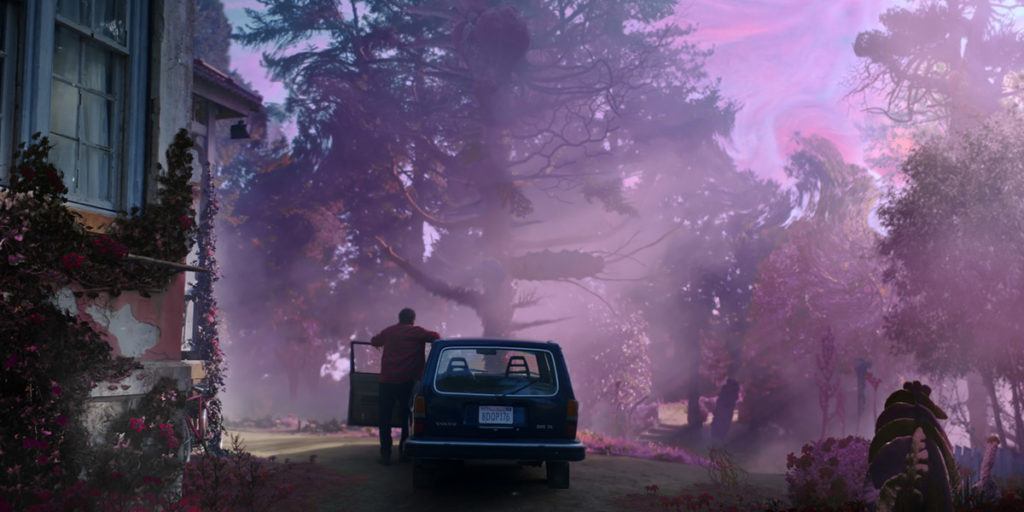Color Out of Space

Image courtesy TIFF.
Based on what H.P. Lovecraft considered among his finest short stories, COLOR OUT OF SPACE finds a unique voice by twisting the existing material into something as mutated as its own ghoulish chimaeras. Nicolas Cage stars as Nathan Gardner, a simple family man fumbling his way through isolated country life after years of urban existence. He hasn’t found his footing, but maintains optimism for the sake of his wife, Theresa (Joely Richardson), recovering from breast cancer. One night, a bizarre cosmic event splits the sky directly above their house, resulting in a sonic boom and technicolor light show. A smoking pink meteor sits in their yard, bringing with it a dangerous alien life form.
Lovecraft’s short story revolves around events that began in 1882, as observed by an unnamed narrator sent to survey the fictional city of Arkham, Massachusetts. Townspeople relay the story of a fallen meteorite and subsequent events—rotting crops, strange animal behavior—which spread insidiously from the point of impact over the course of years. Also slow-acting is Gardner’s descent into madness; it’s discovered that his paranoia drove him to hold his family captive in their home. Descriptions of both the creatures and their environmental effects were kept vague, leaving the reader’s ratcheting sense of dread and imagination to do the work. In COLOR OUT OF SPACE, these specific elements are either updated or altered to better suit both the cinematic medium and our current culture’s need for immediate pay-off.
The surveyor is now a hydrologist named Ward Phillips (Elliot Knight), sent to test the water tables under Gardner’s land for a city project bolstering the mayor’s reelection campaign. He functions as the sane, first-hand observer to the family’s subsequent physical and mental dissolution. The concept of an alien form completely imperceptible to all human senses is fascinating on the page, but would require a delicate touch on film to maintain tension. Instead of going the “high horror” route, director Richard Stanley (HARDWARE) approaches the entire film with unabashed awareness of its almost-absurd premise.
Taking a page from Alex Garland’s ANNIHILATION, Stanley uses eerie auditory effects and near-hallucinogenic imagery to convey the true “alienness” of the interlopers. In contrast, it eschews any attempt to frame the events in grounded, scientific terms. The creature spreads outward from the Gardner farm, rebuilding earth’s ecosystem to mirror its own. We’re treated to lightning-induced mutant hybrids (involving both man and beast) and a deliciously over-the-top Nick Cage performance that results in such quotable lines as, “Just like you handled the alpacas, dad?”.
Those alpacas are the subject of a recurring gag and gift us with a particularly grotesque moment later in the film; although twisted, it never achieves pure terror (See: the bear-human monstrosity in ANNIHILATION). Lovecraft intended his story to be an allegory for radium necrosis, something invisible to our eyes but destructive in a way that invokes atavistic horror—think “mandible porosity”. COLOR OUT OF SPACE isn’t that subtle, but it never tries to be; it prefers its mandibles slick with alien ooze and screaming in agony.